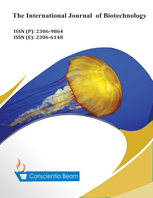The Antimicrobial Activity of Zingiber Officinale Extract (Ginger), Coconut Oil and a Combination of Coconut Oil and Ginger Extract from Different Locations, at Different Concentrations on Wound Infection Bacteria
DOI:
https://doi.org/10.18488/57.v11i2.3242Abstract
The hexane extracts of ginger root (Zingiber officinale) of the Zingiberaceae family and Coconut; Cocos nucifera a member of the Arecaceae family, from two locations in Guyana were used for the investigation of their antibacterial properties. To evaluate the scientific basis for the use of the plant and plant product, the antimicrobial activities of the extracts were evaluated against three common bacteria found on wound infections; Staphylococcus aureus a gram-positive bacteria, Klebsiella pneumoniae a Gram-negative, and Pseudomonas aeruginosa a common encapsulated, facultative aerobic and Gram-negative. The disc diffusion method was used to test the antimicrobial activity of the extracts which were evaluated in 20%, 25%, 50%, 75%, and 100% concentrations against each organism in triplicates, and the diameter of the zone of inhibition was measured. There was no significant difference among the plant extracts from the different locations. The results showed that coconut oil in 50% was most effective against Staphylococcus aureus forming zones measuring 19-20mm, the 100% ginger concentration was most effective against Staphylococcus aureus also and the zones measured 23-15mm, the mixture of ginger and coconut oil was equally effective against Staphylococcus aureus and Pseudomonas aeruginosa with zones measured 12-15mm. The study also investigated the phytochemical constituents of the plant hexane extracts to test the presence or absence of secondary metabolites. Results of the phytochemical studies revealed the presence of tannins, saponins, alkaloids, flavonoids, glycoside, phenol, and steroids in the extracts were active against the bacteria.

